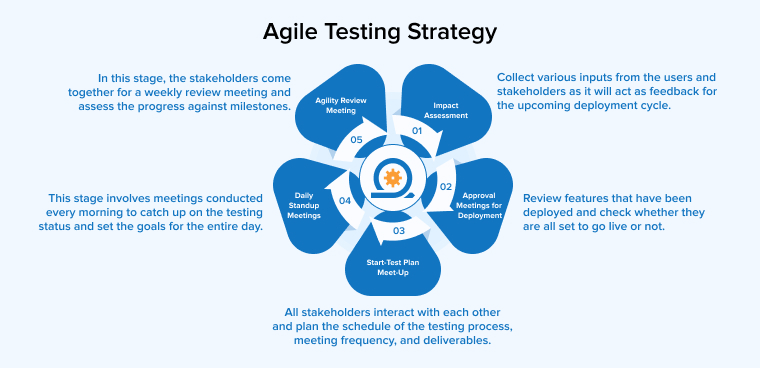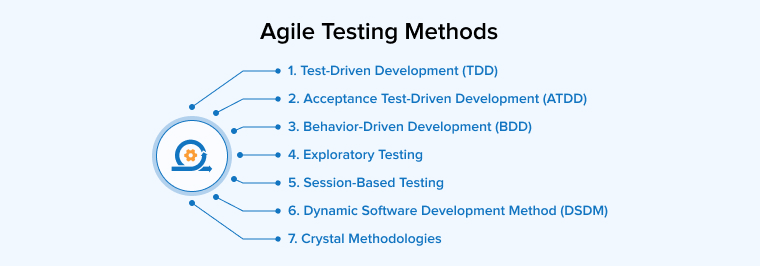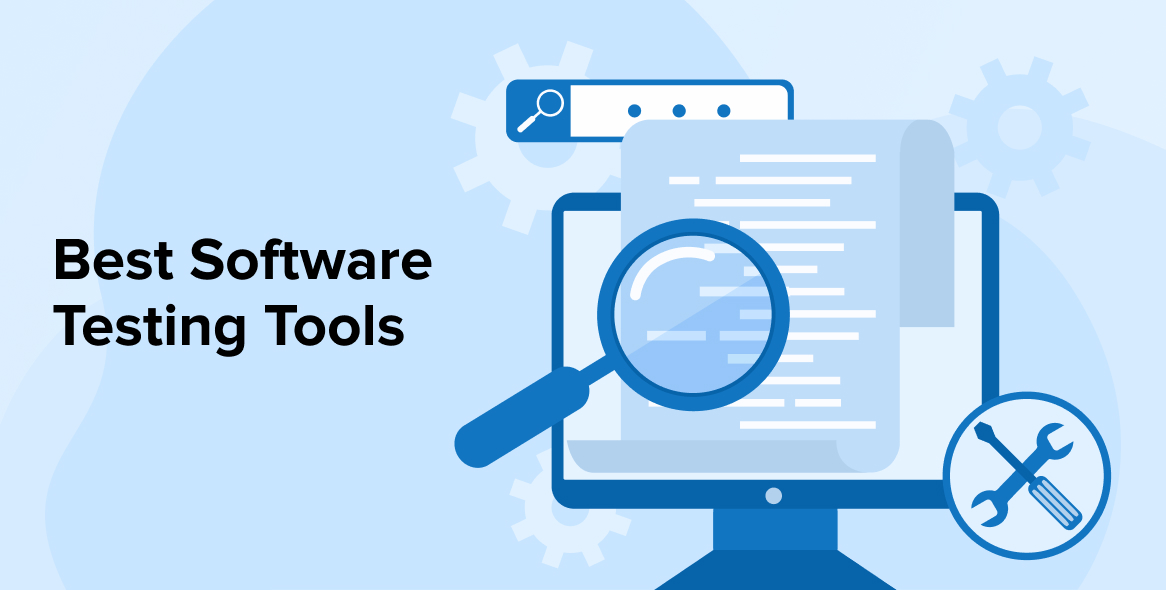
In software development, Agile is one of the most well-known frameworks for project management. Agile is a continuous methodology for software development that focuses on the continuous integration of testing and development. To ensure a high-quality final product that satisfies client needs, testing is not a separate step but rather an integral part of the coding process.
Before hiring a software testing company, let’s understand this topic in detail. This article provides thorough knowledge of different Agile methodologies used in testing.
1. What is Agile Testing?
Agile Testing is a testing methodology that aligns with the standards and concepts of agile software development. In simple terms, Agile testing is a continuous testing process. In the Agile approach, testing is conducted from the beginning and throughout the development cycle rather than at the end. The only purpose is to provide consistent feedback during the development phase because the testing is conducted simultaneously.
Agile testing has grown to the point where experts are no longer a separate organizational unit; they are now also part of an agile software development team. In several agile enterprises, there aren’t any specific positions for analysts or quality assurance experts, so everyone on the team is equally responsible for testing. In other situations, there are test professionals who work closely with software developers throughout the software development life cycle.
1.1 Principles of Agile Testing
Agile testing process is based on the following principles:
- Continuous Testing From the Start: It is recommended that testers begin testing the program at an early stage of development. Additionally, they need to make sure the program is tested consistently during the whole development process.
- Shortening Feedback Iteration: With each iteration of an Agile project, the testing team learns more about the product’s progress and quality. Shorter feedback response times and lower maintenance costs are the results of continuous feedback.
- Less Documentation: Since all test engineers and members of an Agile team use a reusable specification or checklist, less paperwork is required for Agile testing implementation. Moreover, the team prioritizes primary data over secondary analysis.
- Client Engagement: The agile development methodology encourages client involvement at every stage. With their input during each stage, the team can refine their approach over time.
- Clear and Concise Code: Easy and clean code is the result of iteratively fixing bugs and flaws found by the testing or agile teams.
- Test-Driven: To save development time, testing in Agile must be conducted concurrently with development. However, in the conventional method, testing is typically performed either after the implementation phase or during software development.
1.2 Benefits of Agile Test Methodology
The implementation of Agile testing results in significant advantages. Below are some of the most achieved ones.
- A Superior End-Product: Thanks to the continuous process which is essential to the agile methodology, testers can identify bugs at an early stage of development. This testing approach ultimately results in a high-quality product.
- Timely Delivery: The Agile testing approach reduces the development cycle compared to waterfall testing, which can take months or even years to pass between development and market release. This method ensures constant input from consumers, which speeds up the product’s development and allows it to respond quickly to market demands.
- Continuous Monitoring: At the end of each sprint meeting, the client is given a good idea of how far along the project has come. Every sprint concludes with the customer receiving an operational software unit that meets their requirements and aligns with their definition of completion.
- Minimizes Documentation: Agile testing is easier to implement and requires less documentation.
- Enhanced Effectiveness: The development stages in agile software testing are divided into smaller sections so that developers can concentrate and finish one component before moving on to the next. This method is useful for identifying minor errors and increasing productivity.
1.3 Challenges Arise During Agile Testing
There are several reasons why agile testing can be challenging. Teams that use the agile methodology are known for their quick changes and flexibility. Therefore, testers must be flexible and capable of making last-minute adjustments to their strategy.
Some of the challenges that are encountered in agile testing are as follows:
- Adapting to Requirements: When the product’s demands or requirements change towards the conclusion of a sprint, the modifications are typically carried over to the following sprint, adding extra work for developers and testers.
- Choosing the Right Tools: If you use the incorrect tool for agile testing, you will invest both time and money, thus tool selection is essential.
- Tester’s Capability: Important test cases could be unchecked because testers lack the necessary expertise to conduct API and integration testing. Providing testers with training to help them efficiently carry out important tests is one way to address this issue.
- Code Changes Made Multiple Times: The primary difficulty for the quality assurance group in an agile methodology is the frequent and essential requirement of updating and change.
- Test Coverage Is Limited: Agile testing allows for the rapid implementation of new features, reducing the amount of time that testing teams have to determine if these developments meet requirements and answer business needs.
- Obstacles to Performance: Problems with the product’s performance could arise when developers construct it without considering the needs of the end-user and instead rely solely on the specifications. It is possible to locate and eliminate performance bottlenecks with the help of load-testing tools.
2. What Does an Agile Tester Do?
As part of their role as an Agile tester, they work with developers together to identify areas for test automation and to design appropriate frameworks and strategies for the process. In addition, they also work with the product owners to understand their requirements, identify areas of impact, and uncover use cases. Testers and developers have different responsibilities and areas of expertise, yet everyone in the team works toward the same goal: producing top-notch products. However, testers’ responsibilities extend beyond just recording errors and extend to many tasks such as:
- Helping to define user stories and user acceptance criteria alongside stakeholders and the product owner.
- Making and conducting tests that cover both functional and non-functional aspects of the product.
- Performing exploratory testing to identify problems and provide valuable suggestions.
- Consistently contributing to team meetings through stand-ups, sprint planning, and review sessions.
- Inform stakeholders and teammates about test status, difficulties, and issues.
3. Impacts of Agile Methodology in Testing
Agile methodologies involve incorporating tests into the production process. Software engineers are trained to create tests both before and during coding. Each program component is surrounded by a series of unit tests to ensure that it continues to operate as intended. This facilitates identifying and isolating issues as the product changes over time.
Considering that software product development can be reactive, and that a variety of variables can impact efficiency and susceptibility, this is an essential testing skill.
In the development process, engineers are positioned to conduct tests immediately after completing small development tasks. Good cooperation and quicker feedback loops enable issues to be addressed faster, hence reducing the accumulation of more issues. This makes it easier for developers to resolve issues, as their work is more at the forefront of their minds.
Agile businesses frequently provide testers with more instruction and exposure to improved tools, enabling them to develop and execute automated tests across the user interface and software interfaces.
Both automated tests and unit tests are crucial to the agility of teams over a long period. In their absence, Agile techniques can give an early burst of energy but ultimately grind to a standstill when the burden of manual testing finds it difficult to deploy software in quick, incremental increments.
As per Frost & Sullivan’s study, a rising proportion of firms are implementing the Agile approach as part of continual engagement in software development.
Frost & Sullivan reports that the influence of Agile methodology in the software testing industry is gradually growing. “According to the company, in the Agile approach, programmers and analysts cooperate in the initial phases of a product’s development and continue to do so consistently.
The strategy is strongly related to another rapidly expanding trend, the utilization of DevOps. The DevOps approach is at the forefront of the software testing industry. Agile represents a continuous integration environment in software testing, while DevOps is characterized by an iterative development environment, according to the definition.
Companies are implementing this aspect of Agile culture, that integrates Agile testing strategy and architecture with development and operational collaboration across the software development lifecycle. Frost & Sullivan predicts that DevOps will partner with Agile to enhance the chances of producing high-quality and error-free software products since Agile is replacing Waterfall methodology.
As Agile and DevOps are the rising corporate approaches to software testing, automation will be accountable for their successful implementation. The company notes that the quality assurance concepts emphasized by Agile and DevOps cannot be accomplished through manual testing. Testing software by Agile methodologies is a constant procedure, and test automation is an evolving technique that may ensure the process’s effectiveness of the process.
4. Agile Testing Quadrants
The testing process is divided into four stages using multiple quadrants in agile testing, which helps to make the process easier to grasp. There are four distinct phases to the agile testing quadrants, which can be thought of as an older method of testing software applications from beginning to end:
4.1 Quadrant 1 (Automated)
The test engineers’ work revolves around the first agile quadrant, which is concerned with the code’s internal quality and includes test components and test cases. When it comes to automated testing, every single test case is driven by technology.
The following tests can be run inside the first testing quadrant of an agile methodology:
- Unit testing.
- Component testing.
4.2 Quadrant 2 (Automated and Manual)
Expanding the business outcomes of the newly developed software, the second quadrant of Agile testing primarily focuses on the client needs that are communicated to the team before and during the testing process.
In the second quadrant, we find business-driven test cases, such as functional tests both manual and automated, designs, and samples of test scenarios developed by the testers.
The following tests can be performed in quadrant 2:
- Examining potential scenarios and workflow
- Carrying out the pair analysis
- Testing prototype experiences and the user story
4.3 Quadrant 3 (Manual)
Quadrant 3 includes exploratory and usability testing as it considers both the code quality and the user experience. Due to the high levels of instinct, analytical thinking, and client engagement involved, they are often linked with manual testing carried out by experienced QA engineers.
You can conduct the following kinds of tests in Quadrant 3:
- Usability testing
- Collaborative testing
- Exploratory testing
- User acceptance testing
- Pair testing with customers
4.4 Quadrant 4 (Tools)
The product is evaluated or critiqued using the technology-facing assessments in Quadrant Q4. Testing for privacy, maintenance, storage management, integration, connectivity, data migration, services, and recovery are all integral parts of Q4.
The following are the tests that can be performed under Q4:
- Performance testing
- Load testing
- Stress testing
- Scalability testing
Tests in each quadrant often require manual testing, specialized equipment, or automation. Teams can plan based on the test quadrants to assess if they have the necessary resources like hardware, software, data, test environments, and the expertise to complete each type of test. Using a test management system that enables real-time team collaboration is a great way to support the effective communication required for an Agile Testing Quadrants–based testing approach.
5. Agile Testing Life Cycle
As we all know, the Waterfall methodology is a sequential process, while Agile testing is a non-sequential process where it is integrated continuously throughout the development process. Continuous Testing is one of the few continuous activities that take place simultaneously on most agile projects, including
- Continuous Build
- Continuous Integration (CI)
- Continuous Delivery (CD)
- Continuous Deployment
Now let us discuss the agile testing lifecycle which includes the following 5 phases:
- Impact assessment
- Agile Testing Planning
- Release Readiness
- Daily Scrums
- Test Agility Review
Have a look at the picture for more understanding:

6. Agile Testing Methods

Here are five agile testing methods that are used in agile testing methodology:
6.1 Test-Driven Development (TDD)
The foundation of test-driven development (TDD) is testing. This form of development starts with a discussion of what is to be tested, followed by the creation of a user narrative. Therefore, you begin by creating a unit test. Next, you must compose the timeline. Eventually, code is written till unit tests pass.
Generally, TDD is applied to component and unit tests that can be executed using automated testing tools. TDD ensures that the functionalities work as expected.
6.2 Acceptance Test-Driven Development (ATDD)
Acceptance test-driven development (ATDD) is similar to the approach used for acceptance tests. However, ATDD begins with user feedback regarding functionality. This method of development begins with a discussion of the product’s intended application. Therefore, you compose a user acceptability test (UAT). Next, the code is written till it succeeds in the test.
ATDD is commonly applied to acceptance tests. It confirms that the product performs as expected by users.
6.3 Behavior-Driven Development (BDD)
BDD is a combination and precision of TDD and ATDD methods. BDD boosts TDD and ATDD with the following strategies:
- Using the “Five Whys” methodology to each suggested user narrative to establish its objective about commercial results.
- Practicing just those habits that significantly contribute to such business results in reducing waste.
- Improving communication by expressing actions in a single syntax that is readily approachable to domain specialists, analysts, and engineers.
- Using these strategies to the software’s lower degree of complexity.
6.4 Exploratory Testing
Exploratory testing promotes the tester’s independence, competence, and inventiveness, much like other Agile methods do for developers. It promotes doing different test-related tasks, like test design and production, during a project instead of in a predetermined order and during a certain “stage” of the operation. In exploratory testing, the focus is on working software rather than comprehensive documentation. The method also highlights the mutually supporting nature of various procedures, as well as the requirement for a variety of testing strategies as opposed to a formal test strategy.
6.5 Session-Based Testing
Session-based testing is similar to exploratory testing but it is slightly more structured. Instead of determining what to test as you go along, you begin with an objective in mind.
Session-based testing can also be used to uncover flaws that are concealed behind a project.
6.6 Dynamic Software Development Method (DSDM)
When it comes to agile testing, the Dynamic Software Development Method is another great option. It provides a delivery architecture for agile projects and is based on Rapid Application Development (RAD). Put simply, the Dynamic Systems Development Method (DSDM) provides a framework for system development and maintenance, serving as a comprehensive agile code development model. Everyone from end users to developers and testers can benefit from the Dynamic Software Development Method.
6.7 Crystal Methodologies
Instead of relying on methods and tools, this approach prioritizes the users involved and how they engage throughout the project. Three factors—team size, project criticality, and priority—determine whether the crystal technique is appropriate.
7. Conclusion
Software testing based on the Agile approach provides clear benefits to firms seeking to improve their product development, irrespective of the test procedure chosen.
Customers and corporate users will not accept ineffective software, and poor-performing software can negatively impact a company’s reputation. Moreover, given the heightened focus on cyber defense, any program released to the industry with significant risks is very guaranteed to fail.
The Agile method has revolutionized the software development process. More firms are undergoing digitalization to improve data management and the delivery of digital solutions to corporate clients and external consumers. Agile will undoubtedly play a big role as businesses pursue these transformation initiatives.






I highly appreciate the author of this article. You did a great job writing this article. Agile is essential in every software product development process. It is an interactive approach that allows the development team, testing team, and customer to collaborate, give feedback, and so on. After applying the agile methodology in testing, the software development process will be easier and faster, and it will also help to identify and fix bugs early.